Unit_1_人间真情
人教版英语七下Unit 1 单元主题写作指导上册
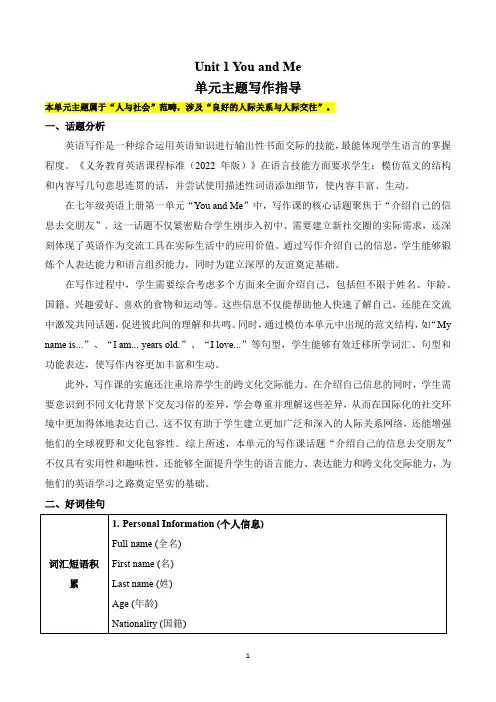
Unit 1 You and Me单元主题写作指导本单元主题属于“人与社会”范畴,涉及“良好的人际关系与人际交往”。
一、话题分析英语写作是一种综合运用英语知识进行输出性书面交际的技能,最能体现学生语言的掌握程度。
《义务教育英语课程标准(2022年版)》在语言技能方面要求学生:模仿范文的结构和内容写几句意思连贯的话,并尝试使用描述性词语添加细节,使内容丰富、生动。
在七年级英语上册第一单元“You and Me”中,写作课的核心话题聚焦于“介绍自己的信息去交朋友”。
这一话题不仅紧密贴合学生刚步入初中、需要建立新社交圈的实际需求,还深刻体现了英语作为交流工具在实际生活中的应用价值。
通过写作介绍自己的信息,学生能够锻炼个人表达能力和语言组织能力,同时为建立深厚的友谊奠定基础。
在写作过程中,学生需要综合考虑多个方面来全面介绍自己,包括但不限于姓名、年龄、国籍、兴趣爱好、喜欢的食物和运动等。
这些信息不仅能帮助他人快速了解自己,还能在交流中激发共同话题,促进彼此间的理解和共鸣。
同时,通过模仿本单元中出现的范文结构,如“My name is...”、“I am... years old.”、“I love...”等句型,学生能够有效迁移所学词汇、句型和功能表达,使写作内容更加丰富和生动。
此外,写作课的实施还注重培养学生的跨文化交际能力。
在介绍自己信息的同时,学生需要意识到不同文化背景下交友习俗的差异,学会尊重并理解这些差异,从而在国际化的社交环境中更加得体地表达自己。
这不仅有助于学生建立更加广泛和深入的人际关系网络,还能增强他们的全球视野和文化包容性。
综上所述,本单元的写作课话题“介绍自己的信息去交朋友”不仅具有实用性和趣味性,还能够全面提升学生的语言能力、表达能力和跨文化交际能力,为他们的英语学习之路奠定坚实的基础。
二、好词佳句三、写作框架四、写作范例请你根据下表内容介绍一下你的新朋友Mike:注意:1. 要点齐全,适当发挥,语言通顺,意思连贯,条理清楚,书写规范;2. 词数80词左右;3. 文中不得提及有关考生个人身份的任何信息。
七上北师大版Unit1关爱家人,表达爱,传递爱教学设计初中英语核心素养学科教学专题培训系列
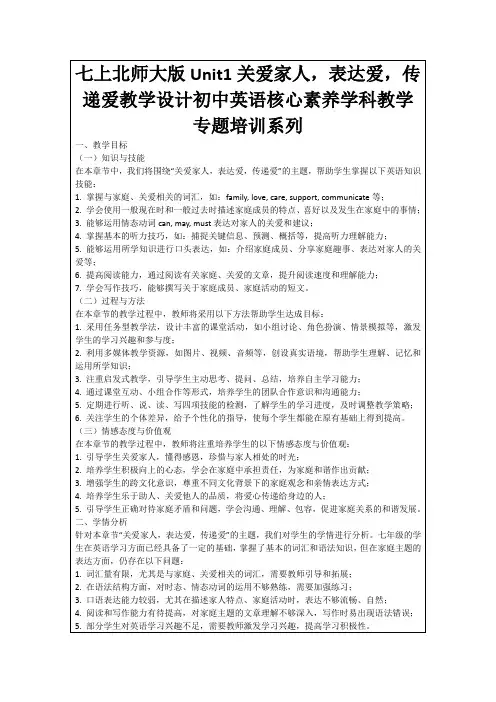
3.阅读理解练习要注重理解文章细节,提高答题准确率。
4.写作训练要注意文章结构、语法正确性和表达流畅性。
5.家庭作业要积极参与,与家人共同完成,增进家庭感情。
6.拓展任务要落到实处,真正为家人付出行动,体验关爱家人的快乐。
教师将根据作业完成情况,给予评价和反馈,鼓励学生不断进步。通过本次作业,希望学生能够将所学知识运用到实际生活中,关爱家人,传递爱。
1.词汇量有限,尤其是与家庭、关爱相关的词汇,需要教师引导和拓展;
2.在语法结构方面,对时态、情态动词的运用不够熟练,需要加强练习;
3.口语表达能力较弱,尤其在描述家人特点、家庭活动时,表达不够流畅、自然;
4.阅读和写作能力有待提高,对家庭主题的文章理解不够深入,写作时易出现语法错误;
5.部分学生对英语学习兴趣不足,需要教师激发学习兴趣,提高学习积极性。
3.教师示范:教师给出示例,展示如何运用所学知识描述家人、表达关爱。
4.学生活动:学生跟随教师示范,进行口语表达练习。
(三)学生小组讨论
1.教学内容:学生以小组为单位,讨论家庭生活、关爱家人的话题。
2.教学活动:
a.小组讨论:学生围绕以下话题展开讨论:
- Describe your family members and their characteristics.
5.家庭作业:与家人共同完成一份“家庭调查问卷”,内容包括家庭成员的喜好、家庭活动安排等,增进对家人的了解。
6.拓展任务:开展一次“关爱家人,从我做起”的实践活动,要求学生为家人做一件力所能及的事情,如:帮忙做家务、为家人准备早餐等,并记录下自己的感受。
1.作业完成要新课
1.教学活动:教师播放一段关于家庭的温馨视频,引导学生关注家庭、关爱家人的主题。
初二作文《人间真情》100字(共11页PPT)

初二作文《人间真情》
科 谁能想到,一个蜚声中外的大
学家,竟还在84岁的高龄,在
晚 生命处于垂危之际,先后五次向
辈求教"补课",孜孜不倦。不能不
好学 说这正是我国谦逊
,不耻下
问,甘拜人师,永不满足的精
神这一传统美德在一个大科学家身
人 上的生动体现,正是他能走向
生光辉顶点的基本要素。
关键词:想到,一个,蜚声中外,
初二作文《人间真情》
" 好一个"我知道得太少"!这种谦
逊好学,不耻下问,甘拜人师, 永不满足的精神,正是我国人 民的传统美德,也是人生道 路上走向光辉顶点的基本要 素。
竺可桢在气象学上辛勤累累。
关键词:一个,知道,这种,谦逊,
好学,不耻下问,甘拜,人师,永不,满 足,精神,正是,我国,人民,传统美德, 人生道路,走向,光辉,顶点,基本要 素,竺可桢,气象学,辛勤耕耘,数十 年如一日,进行,长期,观察,研究,一 生,硕果累累。
初二作文《人间真情》
道路 有这样,才能在求知的崎岖
上奋然前行!
关键词:这样,才能,求知,崎岖,
道路,奋然,前行。
初二作文《人间真情》
驾驭命运的舵是奋斗。
再见
科学家,84,高龄,生命,处于,垂危之 际,先后,五次,晚辈,求教,补课,孜 孜不倦,不能不,正是,我国,谦逊,好 学,不耻下问,甘拜,人师,永不,满足, 精神,传统美德,一个,科学家,身上, 生动,体现,正是,走向,人生,光辉, 顶点,基本要素。
初二作文《人间真情》
怎能不令人深深敬 佩呢?
巨人 人类史上,一个
关键词:不过,自己,觉得,好像,
一个,孩子,海边,玩耍,时候,偶尔, 几只,光亮,贝壳,对于,真正,知识, 大海,还是,没有,发现,这样,谦逊, 好学,永不,满足,精神,牛顿,成功, 必然,古今,事业,大学,无不,是因为, 这种,谦逊,好学,不耻下问,甘拜,人 师,永不,满足,精神,达到,人生,光 辉,顶点。
仁爱版英语九上1(Unit1 Topic1)全英文教案
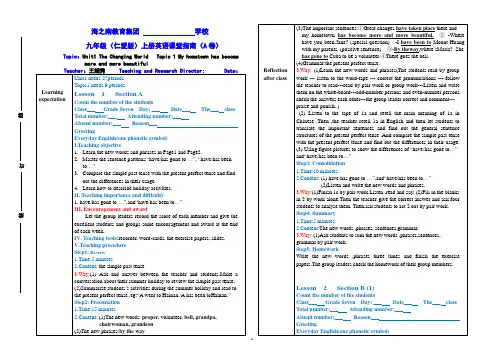
海之南教育集团 学校九年级(仁爱版)上册英语课堂指南(A 卷)Topic :Unit1 The Changing World Topic 1 My hometown has becomemore and more beautifulTeacher :王娟秀 Teaching and Research Director: Date :Learning expectationUnit1 needs 27periods Topic1 needs 9 periods Lesson 1 Section A Count the number of the studentsClass ___ Grade Seven Day: ___ Date ___ The ___ classTotal number:___ Attending number:___Absent number:___ Reason ___GreetingEveryday English(one phonetic symbol)I.Teaching objective1. Learn the new words and phrases in Page1 and Page2.2. Master the sentence patterns:“have/has gone to …”, “have/has beento …”3. Compare the simple past tense with the present perfect tense and findout the differences in their usage.4. Learn how to describe holiday activities.II. Teaching importance and difficulty1. have/has gone to …”,and “have/has been to …”III. Encouragement and awardLet the group leaders record the score of each member and give theexcellent students and groups some encouragement and award at the endof each week.IV. Teaching tools:recorder, word-cards, the exercise papers, slides.V.Teaching procedureStep1: Review1.Time:5 minutes2.Content: the simple past tense3.Way:(1) Ask and answer between the teacher and students.Make aconversation about their summer holiday to review the simple past tense.(2)Summarize students ’s activities during the summer holiday and lead tothe present perfect tense .eg:“A went to Hainan./A has been toHainan.”Step2: Presentation1.Time:15 minutes2.Content: (1)The new words: proper , volunteer, bell, grandpa,chairwoman, grandson(2)The new phrases:by the wayReflection after class(3)The important sentences:①Great changes have taken place there and my hometown has become more and more beautiful. ② -Where have you been,Jane? (special question) -I have been to Mount Huang with my parents. (positive sentence) ③-By theway ,where ’sMaria?–She has gone to Cuba to be a volunteer.④There goes the bell. (4)Grammar:the present perfect tense.3.Way: (1)Learn the new words and phrases(The students read by group work --- listen to the word-tape --- correct the pronunciations --- follow the teacher to read---read by pair work or group work---Listen and write them on the white-board---odd-number persons and even-number persons check the answers each other---the group leader correct and comment--- praise and punish. )(2) Listen to the tape of 1a and retell the main meaning of 1a in Chinese .Then ,the teacher retell 1a in English and then let students to translate the important sentences and find out the general sentence structures of the present perfect tense .And compare the simple past tensewith the present perfect tense and find out the differences in their usage. (3) Using figure pictures to show the differences of “have/has gone to …” and “have/has been to …” Step3: Consolidation 1.Time:10 minutes2.Content: (1) have/has gone to …”,and “have/has been to …”(2)Listen and write the new words and phrases.3.Way:(1)Finish 1c by pair work.Listen ,read and say. (2)Fill in the blanks in 2 by work alone.Then the teacher give the correct answer and ask four students to analyse them. Then,ask students to act 2 out by pair work. Step4: Summary 1.Time:5 minutes2.Content:The new words ,phrases, sentences,grammar.3.Way: (1)Ask students to sum the new words ,phrases,sentences, grammar by pair work. Step5: HomeworkWrite the new words ,phrases three times and finish the exercise papers.The group leaders check the homework of their group members.Lesson 2 Section B (1)Count the number of the studentsClass ___ Grade Seven Day: ___ Date ___ The ___ class Total number:___ Attending number:___Absent number:___ Reason ___ GreetingEveryday English(one phonetic symbol)装订线I.Teaching objective1. Learn the new words and phrases in Page3 and part ones in Page4.2. Go on learning the usage of the present perfect tenseII. Teaching importance and difficulty1.past participle2.-Have/Has +sb+pp.+…?-Yes ,sb.have/has.-No, sb.haven’t/hasn’t. ”III. Encouragement and awardLet the group leaders record the score of each member and give the excellent students and groups some encouragement and award at the end of each week.IV. Teaching tools:recorder, word-cards, the exercise papers, slides.V.Teaching procedureStep1: Review1.Time:5 minutes2.Content: (1)The present perfect tense (2)The important words and phrases learnt last lesson.3.Way:(1) Check the work after class. (2)Review The present perfect tense.(3) dictation.Step2: Presentation1.Time:15 minutes2.Content: (1)The new words: disabled, ever, shut, rope, online, teenager, granny, describe(2)The new phrases:in detail(3)The important sentences:①Have you cleaned rooms for the disabled for the disabled children?(general question) –Yes, I have.②-Have you ever fed them? –No, I haven’t. But I have cooked for them. ③-ThoughI had no time to travel, I still felt very happy.(4)Grammar:the present perfect tense.3.Way: (1)Learn the new words and phrases(The students read by group work --- listen to the word-tape --- correct the pronunciations --- follow the teacher to read---read by pair work or group work---Listen and write them on the white-board---odd-number persons and even-number persons check the answers each other---the group leader correct and comment--- praise and punish. )(2) Show some pictures of disabled children.Make a dialogue with students to know whether they have helped disabled children and lead to 1a.(3) Listen to the tape of 1a and retell the main meaning of 1a in Chinese .Then ,the teacher retell 1a in English and then let students to translate the important sentences and find out the general sentence structures of the present perfect tense . (4) Analyse the important sentences and then practise orally.Step3:Consolidation1.Time:10 minutes2.Content: (1)Review past tense and past participle of verbs .(2)Practise general questions of the present perfect tense in1b3.Way:(1) Review past tense and past participle of verbs by work alone and then, ask several students to sum up the rules. (2) Practise general questions of the present perfect tense in1b by pair work orally and ask some pairs to PK.Step4: Summary1.Time:5 minutes2.Content:The new words ,phrases, sentences,grammar.3.Way:①Ask students to sum the new words ,phrases,sentences, grammar by pair work.Step5: HomeworkWrite the new words ,phrases three times and finish the exercise papers.The group leaders check the homework of their group members. Lesson 3 Section B (2)Count the number of the studentsClass___ Grade Seven Day: ___ Date___ The___ class Total number:___ Attending number:___Absent number:___ Reason___GreetingEveryday English(one phonetic symbol)I.Teaching objective1. Learn the new words and phrase left in Page4.2. Go on learning the usage of the present perfect tense3. Compare the teenagers’ life in the past with that nowadays and lead students to cherish the happy life at present.II. Teaching importance and difficulty1. The new words and phrase2.The present perfect tense.III. Encouragement and awardLet the group leaders record the score of each member and give the excellent students and groups some encouragement and award at the end of each week.IV. Teaching tools:recorder, word-cards, the exercise papers, slides.V.Teaching procedureStep1: Review1.Time:5 minutes2.Content: (1)The present perfect tense. (2)The important words andTeacher’s workis finished. phrases learnt last lesson.3.Way:(1) Check the work after class.(2)Review the present perfect tense (3) dictation.Step2: Presentation1.Time:15 minutes2.Content: (1)The new words: education, childhood, support, laborer,develope, rapidly, luckily, development.(afford)(2)The phrases: a hard life ,in order to ,give support to, a good education,day and night(3)The important sentences:①Can you describe it in detail. ②Parentscouldn’t afford an education for their children. ③In order to help supporttheir families, they had to be child labores. ④Now our country hasdeveloped rapidly.⑤The government gives support to poor families, sochildren can get a good education.(4)Grammar:The present perfect tense.3.Way: (1)Learn the new words and phrases(The students read by groupwork --- listen to the word-tape --- correct the pronunciations --- followthe teacher to read---read by pair work or group work---Listen and writethem on the white-board---odd-number persons and even-number personscheck the answers each other---the group leader correct and comment---praise and punish. )(2) Show some pictures of the life of teenagers in the past. Make adialogue with students to talk about the differences between the life ofteenagers in the past and nowdays lead to 2a.(3) Listen to the tape of 2a and retell the main meaning of 2a inChinese .Then ,the teacher retell 2a in English and then let students totranslate the important sentences and find out the general sentencestructures of the present perfect tense . (4) Analyse the importantsentences and then practise orally.Step3:Consolidation1.Time:10 minutes2.Content: (1)Review past tense and past participle of verbs .(2)Practise general questions of the present perfect tense in1b3.Way:(1) Review past tense and past participle of verbs by work aloneand then, ask several students to sum up the rules. (2) Practise generalquestions of the present perfect tense in1b by pair work orally and asksome pairs to PK.Step4: Summary1.Time:5 minutes2.Content:The new words ,phrases, sentences,grammar.3.Way:①Ask students to sum the new words ,phrases,sentences,grammar by pair work.Step5: HomeworkWrite the new words ,phrases three times and finish the exercisepapers.The group leaders check the homework of their group members.Lesson 4 Section C (1)Count the number of the studentsClass___ Grade Seven Day: ___ Date___ The___ classTotal number:___ Attending number:___Absent number:___ Reason___GreetingEveryday English(one phonetic symbol)I.Teaching objective1. Learn the new words and phrase in Page5 and Page6.II. Teaching importance and difficultyThe usage of the new words and phrase.III. Encouragement and awardLet the group leaders record the score of each member and give theexcellent students and groups some encouragement and award at the endof each week.IV. Teaching tools:recorder, word-cards, the exercise papers, slides.V.Teaching procedureStep1: Review1.Time:5 minutes2.Content: (1)The present perfect tense.(2)The important words andphrases in Page4.3.Way:(1) Check the work after class. (2)Review The present perfecttense (3) dictation.Step2: Presentation1.Time:15 minutes2.Content: (1)The new words: narrow,communication, quick, leisure,relative, mainly, telegram,sort,fax,rapid,progress,already,succeed.(2)The phrases: keep in touch with ,far away ,reform andopening-up,make progress.(ring roads,living conditions)3.Way: (1) Show some pictures of Beijing in the past and at present andask the students to discuss the differences between them lead to the newwords and phrases in 1a.(2)Learn the new words and phrases(The students read by group work ---listen to the word-tape --- correct the pronunciations --- follow the teacherto read---read by pair work or group work---Listen and write them on thewhite-board---odd-number persons and even-number persons check theanswers each other---the group leader correct and comment---praise and punish. )Step3:Consolidation1.Time:15 minutes2.Content: (1)The new words and phrases.3.Way:(1) Practise how to use the new words and phrases by doing the exercise papers. (2) Give the standard answers and ask several students to analyse the questions in their paper.(3) The group leaders correct and supplement some opionions.(4)The teacher comment.Step5: HomeworkWrite the new words ,phrases three times and finish the exercises in the workbooks.The group leaders check the homework of their group members.Lesson 5 Section C (2)Count the number of the studentsClass___ Grade Seven Day: ___ Date___ The___ class Total number:___ Attending number:___Absent number:___ Reason___GreetingEveryday English(one phonetic symbol)I.Teaching objective1.Go on learning the usage of the present perfect tense3. Compare the past Beijing with the present Beijing and learn the great changes in China.4.Inspire students to cherish the happy life at present and to cultivate their patriotism.II. Teaching importance and difficulty1. The present perfect tense.2. Some sentences.III. Encouragement and awardLet the group leaders record the score of each member and give the excellent students and groups some encouragement and award at the end of each week.IV. Teaching tools:recorder, the exercise papers, pictures.V.Teaching procedureStep1: Review1.Time:5 minutes2.Content: (1)The present perfect tense. (2)The words and phrases learnt last lesson.3.Way:(1) Check the work after class.(2)Review the present perfect tense (3) dictation.Step2: Presentation1.Time:15 minutes2.Content:(1)The important sentences:①My granny has lived in Beijing for more than forty yeas.②People kept in touch with their friends and relatives far away mainly by letter or telegram. ③Beijing has made rapid progress and it has already succeeded in hosting the 2008 Olympic Games.3.Way: (1)Let the students look at the pictures in 1a and disscuss the differences in English using the simple past tense and the present perfect tense. (2) Listen to the tape of 1a and retell the main meaning of 1a in Chinese .Then ,the teacher retell 2a in English and then let students to translate the important sentences analyse the important sentences and then practise orally. (3) Let students finish 1b by work alone.Then,check the answers.Step3:Consolidation1.Time:10 minutes2.Content: (1)The important sentences and the present perfect tense.3.Way:(1) Fnish 1c by pair work.Step4: Extension1.Time:5 minutes2.Content: The changes in our hometown.3.Way:①Discuss the changes in our hometown by group work.Step5: HomeworkWrite the important sentences and finish the exercise papers.The group leaders check the homework of their group members.Lesson 6 Section DCount the number of the studentsClass___ Grade Seven Day: ___ Date___ The___ class Total number:___ Attending number:___Absent number:___ Reason___GreetingEveryday English(one phonetic symbol)I.Teaching objective(1)The new words:organization,composition,note,consider, tool. (2)Thephrases: draw up, thanks to (3)Review and sum up the importantwords, phrases,sentences and the present perfect tenseII. Teaching importance and difficulty1.The dictation and usage of the important words,phrases,sentences and the present perfect tenseIII. Encouragement and awardLet the group leaders record the score of each member and give the excellent students and groups some encouragement and award.IV. Teaching tools: word-cards.V.Teaching procedureStep1: Learn new words and phrases1.Time:10 minutes2.Content:The new words:organization, composition, note, consider, tool.(2)The phrases: draw up, thanks to3.Way: (1)Learn the new words and phrases(The students read by group work --- listen to the word-tape --- correct the pronunciations --- follow the teacher to read---read by pair work or group work---Listen and write them on the white-board---odd-number persons and even-number persons check the answers each other---the group leader correct and comment--- praise and punish. )Step2: Review1.Time:15 minutes2.Content: (1) the important words,phrases,sentences and the present perfect tense3.Way:(1) ①Divide the students into four groups.Then,let the students go to the white-board to write down the important words or phrases or sentences or grammars.②The group leaders record the results and hand them in.Step3: Comment and supplement.1.Time:10 minutes3.Way: (1)The teacher comment the students’show and supplement some points.(2) Give the groups and persons praise and award that are of the first three places.Lesson 7 (Composition)Count the number of the studentsClass___ Grade Seven Day: ___ Date:___ The___ class Total number:___ Attending number:___Absent number:___ Reason___GreetingEveryday English(one phonetic symbol)I.Teaching objectiveLearn the basic steps of writing a composition.II. Teaching importance and difficulty1.How to write a composition to the pictures.III. Encouragement and award(1)Praise students writes well point out the advantages and disadvantages of the students’ compositions.IV.Teaching procedureStep1 Discussion1.Time:10 minutes2.Content:The basic steps of writing a composition3.Way: (1)Discuss how to write the composition in 4 of Section D. (2)The teacher sum up the basic steps.Step2 Writing1.Time:20 minutes2.Content: (1) A composition about the changes in Li Ming’s hometown according to the pictures in 4.3.Way:(1) Write a composition by work alone. (2) Read over and give remarks by pair work..Step3 Comment1.Time:10 minutes2.Content:The compositions of each students.3.Way: (1)The group leaders skim through their members’compositions and remarks and sum up the advantages and disadvantages and pink out the best compositions to give them to the teacher .(2 Let two students to read two best compositions and let all the students to find out the advantages and disadvantages and discuss how to revise the disadvantages.(3)The teacher comments,summarizes and praise.Lesson 8 (practice)Count the number of the studentsClass___ Grade Seven Day: ___ Date:___ The___ class Total number:___ Attending number:___Absent number:___ Reason___GreetingEveryday English(one phonetic symbol)I.Teaching objectivePractice and consolidate the important knowledge in Topic1 of Unit 1.II.Teaching procedureStep1 the students finish Paper B1.Time:40 minutes2.Content:Paper B3.Way: Finish Paper B at one lesson .Lesson 9 (The assessment of Paper B)Count the number of the studentsClass___ Grade Seven Day: ___ Date:___ The___ class Total number:___ Attending number:___Absent number:___ Reason___GreetingEveryday English(one phonetic symbol)I.Teaching objectivePractice and consolidate the important knowledge in Topic1 of Unit 1.II.Encouragement and award:Praise the persons and groups which do well .III.Teaching procedureStep1Check Paper B1.Time:10 minutes2.Content:Paper B3.Way: Check Paper B by pair work,Then, the group leaders sum up the problems which are done badly.Step2 Analyse and assess Paper B1..Content:Paper B2..Way: (1)Analyse and assess it by some students and then the group leaders.(2)The teacher gives them some help if there is need.(3) The teacher comments and praise the persons and groups which do well .。
Unit 1 Topic 3 Section B-七年级英语上册课件(仁爱版)
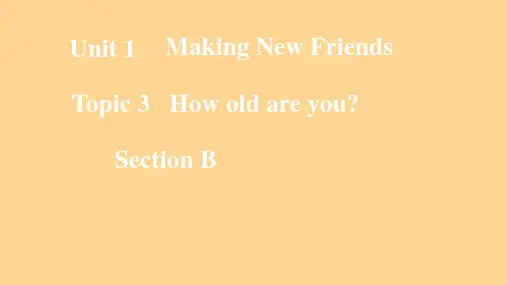
a desk/desk/
an eraser /i'reɪsə(r)/
Key points
Wang Junfeng: Excuse me, what’s this in English?
Jane: It’s an eraser.
这用英语怎么说?
Wang Junfeng: How do you spell it? Jane: E-R-A-S-E-R, eraser. 怎么拼读呢?
Is this a t_e_l_e_p_h_o_n_e_? No, it isn’t. It’s a _t_o_y_.
Is that a toy, too?
No, it’s an _e_r_a_s_e_r_.
An eraser? Wow!
eraser pencil toy telephone map
不定冠词
A: Excuse me , what’s _t_h_is_ in English? A: Excuse me, what’s _t_h_a_t in English?
B: It’s ___ห้องสมุดไป่ตู้__ pencil.
B: It’s __a_n__ apple.
A: How do you spell it?
Jane: Yes. M-A-P, map.
Wang Junfeng: Thanks.
Jane: You’re welcome. 不用谢。
谢谢的相关表达: Thanks! Thank you! Thank you very much! Thanks a lot!
不用谢的相关表达: You’re welcome. That’ s OK. That’s all right. Not at all.
人间真情作文700字
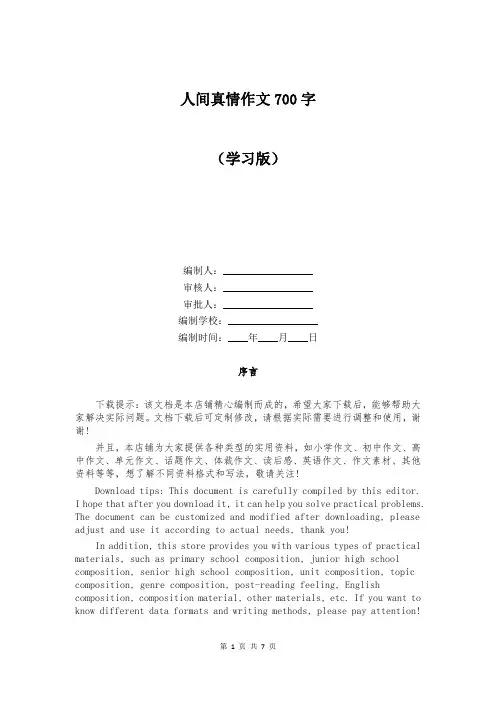
人间真情作文700字(学习版)编制人:__________________审核人:__________________审批人:__________________编制学校:__________________编制时间:____年____月____日序言下载提示:该文档是本店铺精心编制而成的,希望大家下载后,能够帮助大家解决实际问题。
文档下载后可定制修改,请根据实际需要进行调整和使用,谢谢!并且,本店铺为大家提供各种类型的实用资料,如小学作文、初中作文、高中作文、单元作文、话题作文、体裁作文、读后感、英语作文、作文素材、其他资料等等,想了解不同资料格式和写法,敬请关注!Download tips: This document is carefully compiled by this editor.I hope that after you download it, it can help you solve practical problems. The document can be customized and modified after downloading, please adjust and use it according to actual needs, thank you!In addition, this store provides you with various types of practical materials, such as primary school composition, junior high school composition, senior high school composition, unit composition, topic composition, genre composition, post-reading feeling, English composition, composition material, other materials, etc. If you want to know different data formats and writing methods, please pay attention!人间真情作文700字【第1篇】《爸爸,我爱您!》我有一位爱笑的爸爸。
仁爱版英语九年级上册Unit 1 Topic 3《The world has changed for
仁爱版英语九年级上册Unit 1 Topic 3《The world has changed for the better》SectionB 教案一. 教材分析本课选自仁爱版英语九年级上册Unit 1 Topic 3《The world has changed for the better》。
本节课主要讨论了人们的生活在科技发展的影响下发生了很大的变化。
通过本节课的学习,学生能够了解科技发展对人们生活的影响,提高他们的英语语言运用能力。
二. 学情分析九年级的学生已经具备了一定的英语基础,能够理解和运用一些基本的英语词汇和句型。
但是,对于一些较高级的词汇和句型,他们可能还需要进一步的学习和掌握。
此外,学生可能对科技发展对生活的影响这个主题有一定的了解,但还需要通过英语学习来进一步拓展和提高。
三. 教学目标1.知识目标:–学生能够掌握和运用本节课所学的词汇和句型。
–学生能够理解并运用本节课所学的语法知识。
2.能力目标:–学生能够通过听、说、读、写等方式运用英语进行交流和表达。
–学生能够通过小组合作、讨论等方式提高他们的团队合作和沟通能力。
3.情感目标:–学生能够认识到科技发展对人们生活的影响,提高他们对科技发展的认识和理解。
–学生能够培养对英语学习的兴趣和热情,提高他们的学习动力。
四. 教学重难点•学生能够掌握和运用本节课所学的词汇和句型。
•学生能够理解并运用本节课所学的语法知识。
•学生能够运用本节课所学的词汇和句型进行流畅的英语表达。
•学生能够正确运用本节课所学的语法知识进行正确的句子构造。
五. 教学方法本节课采用任务型教学法、情境教学法和分组合作教学法。
通过设置各种任务和情境,引导学生主动参与学习过程,提高他们的英语语言运用能力。
同时,通过分组合作,培养学生的团队合作和沟通能力。
六. 教学准备1.教师准备:–准备好本节课所用的教学材料,如PPT、单词卡片、练习题等。
–提前给学生发放相关的学习材料,让他们预习。
人教版 小学语文 四年级上册 1-6单元各课主题,识字表,写字表,词汇表,教学知识点
五年级教学知识点(上册)第一单元自然奇观Lesson 1 《观潮》了解钱塘江大潮壮丽奇特的自然景象,感觉自然之壮美。
o Characters for reading: 罩屹鼎沸贯崩恢(多音字:称号薄)o Characters for writing: 潮称盐笼罩蒙薄雾昂沸贯旧恢o Vocabulary for reading and writing: 宽阔笼罩薄雾若隐若现昂首东望风平浪静水天相接沸腾横贯江面齐头并进奔腾漫天卷地依旧恢复 Lesson 2 《雅鲁藏布大峡谷》感悟大自然的神奇,进而产生热爱大自然的思想感情。
o Characters for reading: 穆玛涓滔脉卉罕(多音字:藏切秘)o Characters for writing:o Key words:珠穆朗玛峰涓涓细流滔滔江水山脉花卉人迹罕至 Lesson 3 《鸟的天堂》本文作者记叙了两次经过“鸟的天堂”的所见所闻,表达了作者对大自然的热爱。
o Characters for reading: 茫桨律榕隙耀暇抛 (多音字:数应禁兴)o Characters for writing: 灿烂竿茫桨规律支株缝隙耀梢寂o Vocabulary for reading and writing: 灿烂竹竿白茫茫规律缝隙照耀树梢静寂o学运用:点面结合(“点”的详细描写和“面”概括性描写有机结合。
点面结合可以既有深度游有广度地反映人、事、景物的形象状态。
) Lesson 4《火烧云》本文写了火烧云上来和下去的全过程,为我们勾画了一幅绚丽多姿的晚霞美景图。
表达了作者对自然景观的喜爱和赞美。
o Characters for reading: 檀盈凶庙惚 (多音字:乘模转)o Characters for writing:o Key words:紫檀色笑盈盈凶猛庙门恍恍惚惚Text used:《语文园地一》o Review the key vocabulary in unit 1: 词语盘点:宽阔笼罩薄雾若隐若现昂首东望风平浪静水天相接沸腾横贯江面齐头并进奔腾漫天卷地依旧恢复灿烂竹竿白茫茫规律缝隙照耀树梢静寂o日积月累:理解并背诵o Guidance for writing 写作指导: 介绍景物特点第二单元观察与发现Lesson 5《古诗两首》——《题西林壁》写了作者游庐山时的所见、所想。
九年级英语上册Unit 1 Topic 3 Section B精品课件 最新仁爱版
6. He _b_o_r_r_o_w__e_d_ (borrow) the car in 2008. He _h_a__s_k_e_p__t _ (keep) the car for one year.
We can also tell the story like this :
Xiao Lin is not only the secretary of the Helpers’ Club but also an excellent computer engineer. He’s the son of a fisherman. His father has been dead for many years . He has been away the army for twelve years because of a leg wound. He has been in Beijing since 2003. He has been a member of Helpers’ Club since 2004. He has had a house since 2005. He has kept the car for two years.
5. The world has not changed people’s lives ( F)
1a Look , listen and say
1c Read 1a and fill in the blanks .
There is a wonderful program that helps
九年级英语上学期Unit-1课件4
在线电影 抖音怎么发电视剧片段,希望能够给大家带来帮助,感兴趣的朋友赶快来围观吧!软件版本:抖音V10.2.0演示机型、适用系统:小米8MIU111 在线电影 1、首先需要把电视剧片段录屏,打开手机上的抖音。2、点击屏幕下方中间的+号,点击上传,选择录好屏的电视剧片段。选择好后点击下一步。3、可以对内容进行裁剪,保留想要的部分。点击,下一步,还可以设置滤镜、变声、字幕等。4、屏幕下方可以设置配音、特效、文字、贴纸 在线电影 蒋梦婕,1989年12月7日出生于安徽省芜湖市,毕业于舞蹈学院芭蕾舞专业,中国内地女演员。2010年,凭借出演个人首部电视剧《红楼梦》获得国剧盛典最佳新人奖。2011年,凭借个人首部电影《百年情书》获得获得百合奖优秀女演员奖。 在线电影 蒋梦婕 在线电影 1、蒋梦婕在《刺青》中饰演宁沉香,宁府大小姐2、蒋梦婕在《绝命追踪》中饰演郁子,帅气神秘的女忍者3、蒋梦婕在《聊斋新编》中饰演小曼,出自《花姑子》单元,花姑子,蛇妖素嬛的养女,是个古灵精怪的女骗子。4、蒋梦婕在《生死相依》中饰演梁素素5、蒋梦婕在《一克拉梦 在线电影 看到电视剧中的农民,头巾包得干净利落,干活好方便,便欣然学着包了一下。意外发现还可以狠有型哟(看到图2没!!!) 在线电影 毛巾一条 在线电影 1、摊开毛巾,一条边折进5cm左右,将这条边的中点置于眉心上方1cm处,不要遮盖眼眉,剩下的覆盖在头上。 在线电影 2、牵着毛巾的两端从耳朵上方绕道后脑勺处,交叉。记得把耳朵露出来,耳朵被夹着一半会很不舒服。3、毛巾的两端交叉后“原路返回”,来到额前,打个普通的结。整理一下,让毛巾的两端向上翘起。4、回到后脑勺处,将后面剩余的毛巾折叠起来,塞进步骤二——交叉后所得的空 在线电影 有什么软件一键安装,免费观看高清电视剧或电影呢?小编向你们推荐一个不错的软件,里面片源更新都很全 在线电影 Windo
- 1、下载文档前请自行甄别文档内容的完整性,平台不提供额外的编辑、内容补充、找答案等附加服务。
- 2、"仅部分预览"的文档,不可在线预览部分如存在完整性等问题,可反馈申请退款(可完整预览的文档不适用该条件!)。
- 3、如文档侵犯您的权益,请联系客服反馈,我们会尽快为您处理(人工客服工作时间:9:00-18:30)。
纪,在自己温暖的床上老去。
old lady 在该句中为谓语补语,形容词也可以有类似用法。 e.g. He died young.
5. You must do me this honor. 你要答应我。
do sb. an honor 赏光,给某人一个面子 e.g. Will you do me the honor of becoming my wife?
学林出版社
Back Next
Moving Stories 1
感人故事1
3
Focus
S: A song: My Heart Will Go On L: Holding on and never giving up (1) L: Holding on and never giving up (2) S: Telling a story R: It was worth every penny W: Writing a thank-you letter R: Kindness
holding on to the piece of wood that Rose is lying on. Listen to their
dialogue and answer the questions.
Back
Next
学林出版社
2. Holding on and never giving up (1)
Back
Next
学林出版社
2. Holding on and never giving up (1)
Notes
10
1. It‟s going to take them a couple of minutes to get the boats organized... 组织到船得需要几分钟…… *organize vt. 组织,安排 该动词的名词形式是organization。 e.g. The course was organized by a training company. Students need to learn to organize their lives. 2. I don‟t know about you, but I intend to write a strongly worded letter to the White Star Line about all this. 不知道你会怎么做,反正我想写一封措辞 强烈的信给白星航运公司投诉这件事。 *intend v. 打算,计划 e.g. I intend to get there as soon after 5 o‟clock as I can. a strongly worded letter 一封措辞强烈的信 此处word 是一个动词,意思是“措词,用词”。 e.g. How can we word the letter so as not to offend the parents?
Back Next
学林出版社
2. Holding on and never giving up (1)
3. I love you, Jack. 我爱你,杰克。
11
西方人习惯在弥留之际对自己的亲人说“我爱你”。由此可见露丝觉得 自己快坚持不下去了,她在向杰克告别。 4. You‟re going to go on and you‟re going to make lots of babies and you‟re going to watch them grow and you‟re going to die an old, old lady, warm in your bed. 你一定能活下去,生许多孩子,看着他们长大。你能活到很大年
1. How does Rose feel? She feels cold. 2. Is she confident of survival? No, she isn‟t. 3. What does Jack do to encourage Rose? He keeps telling her never to let go / give up. 4. What does Jack make Rose promise?
7
To never give up no matter what happens or how hopeless things are.
Back
Next
学林出版社
2. Holding on and never giving up (1)
8
Rose: It‟s getting quiet. Jack: It‟s going to take them a couple of minutes to get the boats organized... I don‟t know about you, but I intend to write a strongly worded letter to the White Star Line about all this. Rose: I love you, Jack. Jack: No... Don‟t you do that. Don‟t say your good-byes. Not yet. Do you understand me? Rose: I‟m so cold. Jack: Listen, Rose. You‟re going to get out of here. You‟re going to go on and you‟re going to make lots of babies and you‟re going to watch them grow and you‟re going to die an old, old lady, warm in your bed. Not here. Not this night. Not like this. Do you understand me?
To be continued
Back Next
学林出版社
2. Holding on and never giving up (1)
9
Rose: I can‟t feel my body. Jack: Winning that ticket was the best thing that ever happened to me.
5
Back
Next
学林出版社
2. Holding on and never giving up (1)
6
The Titanic is sinking quickly. Jack and Rose fall into the water. Jack rises, kicking to the surface, and pulls Rose onto a piece of wood. Now Jack and Rose are drifting in the black water, Jack
It brought me to you. And I‟m thankful for that, Rose, I‟m thankful. You must do me this honor. You must promise me that you will survive ... that you won‟t give up ... no matter how hopeless. Promise me now, Rose, and never let go of that promise. Rose: I promise. Jack: Never let go. Rose: I will never let go, Jack. I‟ll never let go.
Back Next
学林出版社
2. Holding on and never giving up (1)
12
6. You must promise me that you will survive ... that you won‟t give up ... no matter how hopeless. 答应我活下去„„无论发生什么„„无论多么绝望„„ 决不放弃。 *survive v. 生存,活下去,幸存下来 e.g. In the jungle, they were driven to extremes in order to survive. 该动词的名词形式是survival。 e.g. A lot of small companies are having to fight for survival. give up 放弃;认输 e.g. The patient was dying, but the doctors didn‟t give up on him. I give up and I quit. *hopeless a. 无望的 e.g. We tried to stop the flames from spreading, but we knew it was hopeless. 7. Promise me now, Rose, and never let go of that promise. 答应我,露丝,永 不放弃。 let go (of) 放弃;松手;对„„不予追究或考虑 e.g. However hopeless it is, we will hold on and never let go.
Back Next
学林出版社
1. Starter — A song: My Heart Will Go On
My Heart Will Go On Every night in my dreams I see you, I feel you That is how I know you go on Far across the distance and spaces between us You have come to show you go on Near, far, wherever you are I believe that the heart does go on Once more, you open the door And you're here in my heart And my heart will go on and on Love can touch us one time And last for a lifetime And never let go till we ’re gone Love was when I loved you One true time I hold to In my life we’ll always go on
